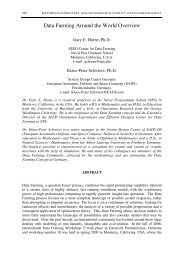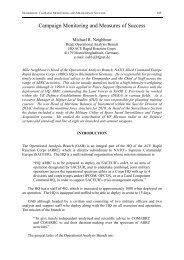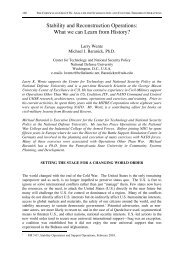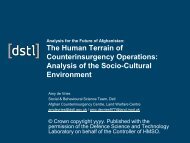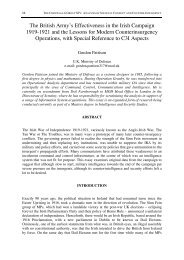Modeling Stability and Reconstruction Operation ... - Cornwallis Group
Modeling Stability and Reconstruction Operation ... - Cornwallis Group
Modeling Stability and Reconstruction Operation ... - Cornwallis Group
Create successful ePaper yourself
Turn your PDF publications into a flip-book with our unique Google optimized e-Paper software.
226 THE CORNWALLIS GROUP XI: ANALYSIS FOR CIVIL-MILITARY TRANSITIONSSTABILITY AND RECONSTRUCTION OPERATION (2)Though the scope can vary on a case by case basis, stability <strong>and</strong> reconstruction operations is abroad brushed approach to stabilizing <strong>and</strong> reconstructing conflict-ridden regions <strong>and</strong>/orregions devastated by endemic poverty <strong>and</strong> natural disasters. According to USAID, stability<strong>and</strong> reconstruction operation consists of three interrelated objectives:• <strong>Stability</strong> that is advancing a degree of stability <strong>and</strong> personal security foraffected individuals sufficient enough to assure their survival <strong>and</strong> be able toengage in basic economic activity. These include micro interventions such ashumanitarian assistance such as food, water, shelter <strong>and</strong> a secure environmentfor the people as well as an environment conducive to the repatriation ofInternally Displaced Persons <strong>and</strong> refugees, <strong>and</strong> more often than notdiplomatic, political, <strong>and</strong> military interventions to bringing warring parties toagreement.• Reform that is addressing issues of institutional reform thereby increasingstate’s effectiveness <strong>and</strong> legitimacy.• Capacity that is developing capacity of institutions <strong>and</strong> infrastructurefundamental to advancing lasting recovery. Capacity building targetsdeveloping institutions at the local, regional <strong>and</strong> national levels.While the first objective may be short term, reform <strong>and</strong> capacity building are considerableundertakings requiring long-term commitment <strong>and</strong> resources from aid agencies.In recent years agencies have undertaken various mix of approaches to ensure maximumsuccess. Two dominant approaches are the minimalist aid versus the maximalist effort.According to Goodh<strong>and</strong> (2004) the maximalists argue that aid should be consciously used asan instrument of peace building. It should be comprehensive strategy with the goal ofproviding a mixture of humanitarian, rehabilitation <strong>and</strong> development assistance that would inturn affect the behavior of various actors. Minimalists question the broadening of the aid’sm<strong>and</strong>ate <strong>and</strong> assume a clear distinction between humanitarian aid <strong>and</strong> development goals.While normative debate is extensive, scholars agree that there is clearly a lack ofempirical evidence that would support either of these methods. Due to the paucity of realworld examples, challenges of data collection, issues with level of analysis <strong>and</strong> time frames,<strong>and</strong> measurement gaps, very little is known about the linkages between aid <strong>and</strong> the dynamicsof violence, as well as its direct linkages with development <strong>and</strong> state-building.SYNTHETIC ENVIRONMENT FOR ANALYSISAND SIMULATION (SEAS) (3)Synthetic Environments for Analysis <strong>and</strong> Simulation (SEAS) (Chaturvedi et al. 2004, 2005)provides an agent-based framework that is unbiased to any specific school of thought,scenario, model, or system paradigm.



